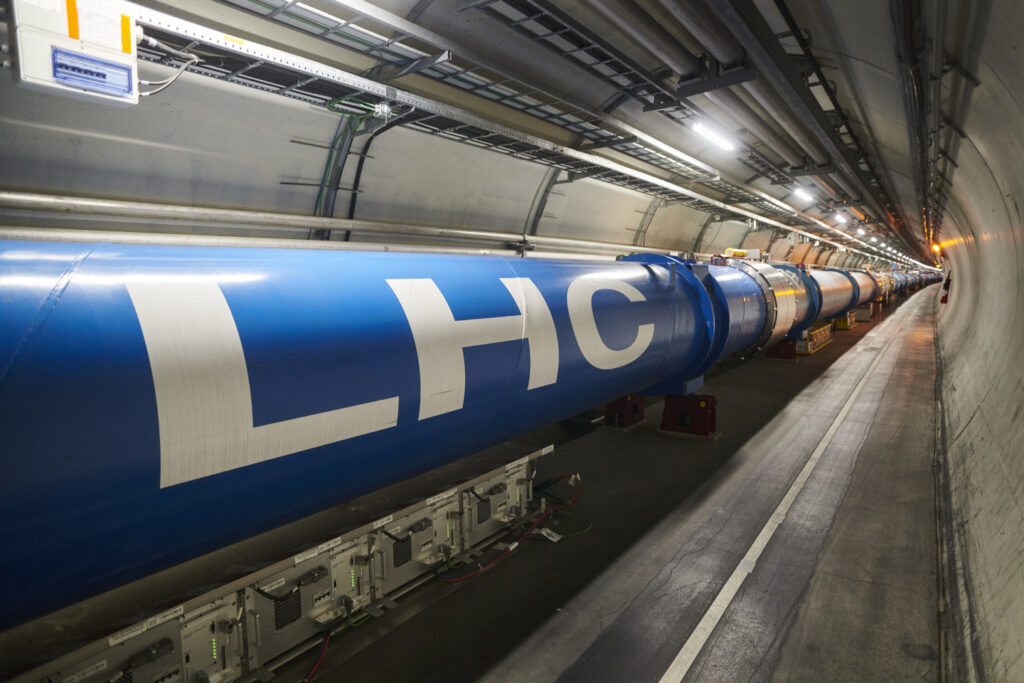
A new period of data taking, Run 3, for the experiments at the world’s most powerful particle accelerator, the Large Hadron Collider (LHC) at CERN, started on 5 July. The LHC will run around the clock for almost four years at a record energy of 13.6 TeV, providing unprecedented precision and discovery potential.
The launch of LHC Run 3, which was streamed live by CERN, comes after more than three years of upgrade and maintenance work. During this period, known as Long Shutdown 2,many interventions were carried outto enable the accelerator to reach a new record energy level.
Following these interventions, scientists will now be able to observe previously inaccessible processes and improve the measurement precision of numerous known processes, addressing fundamental questions, such as the origin of the matter-antimatter asymmetry in the universe.
“The Long Shutdown 2 involved the upgrade not only of the LHC,” explained Roberto Tenchini, president of the National Scientific Committee for particle physics of the National Institute for Nuclear Physics(INFN). “The four big experiments underwent major upgrades to their data readout and selection systems, with new detector systems and computing infrastructure, to provide maximum efficiency under the new conditions.”
The four Large Hadron Collider experiments – CMS, ATLAS, LHCb and ALICE – are run by major collaborations to which Italy contributes significantly under the coordination of the National Institute for Nuclear Physics (INFN).
CMS (Compact Muon Solenoid) – and ATLAS are the two main particle detectors at the LHC. Although they share the same scientific objectives – from the study of the Standard Model to the search for extra dimensions and particles that could make up dark matter – they use different technological solutions.
“The major upgrades to CMS carried out during the second Long Shutdown involved many of the main components of the experiment,” explained Lucia Silvestris, INFN, coordinator of the CMS experiment Italian collaboration. “The activity was completed within its scheduled time frame with the vital contribution of the INFN researchers involved in the collaboration. The increased data samples and higher collision energy achieved with Run 3 will further expand the already very diverse physics programme of the CMS experiment. The objectives of the experiment will range from the study of the Higgs sector to precision measurements of Standard Model quantities, such as W-boson and top-quark masses, up to the search for new particles or anomalies in B meson physics.”
“Continuing a tradition that has seen the Institute at the forefront in the implementation of the experiment and in the discovery of the Higgs boson, the INFN, involved in the ATLAS collaboration with as many as 14 different groups from its sections and laboratories and with a number of young researchers, undoubtedly played a leading role in the intense detector upgrade work recently concluded. This commitment will obviously continue in the new data-taking period. One of the main objectives of this phase will be the detailed study of the properties of the Higgs boson, and in particular of the mechanisms through which it couples both to other particles and to itself,” explained Stefano Giagu, INFN, coordinator of the ATLAS experiment Italian collaboration.
The LHCb and ALICE experiments also underwent major upgrades.
“The LHCb experiment, where b stands for beauty, specializes in studying a very special quark known as ‘beauty quark’,” said Vincenzo Vagnoni, INFN, national spokesperson for LHCb. “The characteristics of this quark make it particularly useful for studying with precision the differences in the behaviour of matter and antimatter, between beauty quark and anti-beauty quark. In its first life, the experiment had already made the world’s most precise measurements of these differences allowing the LHCb collaboration, involving some 1,500 scientists from around the world, including 16% from the INFN, to publish more than 600 scientific papers. Now the experiment starts a new life, with a completely refurbished detector and a capacity to collect and analyse data improved by an order of magnitude. The detector will be acquiring data for several years, and the LHCb collaboration is already thinking about how to modernize the technology to produce a further improvement in the 2030s, in what will be LHCb’s third life.”
“During these three and a half years, the large ALICE detector, which studies in particular primordial states of matter, has undergone major changes,” said Massimo Masera, INFN, national spokesperson for ALICE. “Some of the detectors are completely new and all the others have been adapted to the data-taking conditions of LHC Run 3. Thanks to this major upgrade, ALICE will be able to carry out precision measurements on a large amount of data. The INFN community has worked hard and well to get to this stage in time, despite the difficulties of the last two years, and we can say with great satisfaction that the experiment is ready for the new challenges that lie ahead.”
The small experiments – TOTEM, LHCf, MoEDAL, with its entirely new MAPP subdetector, and the recently installed FASER and SND@LHC experiments – are also ready to explore phenomena within and beyond the Standard Model, from magnetic monopoles to neutrinos and cosmic rays. A new physics season has started, with a broad and promising scientific programme in store.

